Jupiter in 2012/13: Interim report no.9 (2013 Jan.):
Interim report on Jupiter, 2012 Aug.-Dec.
January 21, 2013
John Rogers (British Astronomical Association),
including results from the JUPOS team
(Gianluigi Adamoli, Michel Jacquesson, Marco Vedovato, Hans-Joerg Mettig & Grischa Hahn)
|
Japanese (translated by Yuichi Iga)
Appendices 1-6
Appendix 1: NNTZ: Anticyclonic ovals, 2008-2012 (Gianluigi Adamoli & John Rogers)
Appendix 2: NEBn: Dynamic interactions of spots
Appendix 3: Equatorial Band: Tracking the f. end
Appendix 4: SEBn: A new South Equatorial Disturbance?
Appendix 5: Zonal wind profiles (Grischa Hahn)
Appendix 6: Fireballs on Jupiter (Dr Ricardo Hueso)
|
Appendix 1:
NNTZ: Anticyclonic ovals, 2008-2012
Gianluigi Adamoli & John Rogers
Here we update the history of the anticyclonic ovals in the NNTZ, as previously described in Ref. [3]. Their history is summarised in the JUPOS chart in Figs.A1 & A2 (presented in both L2 and L3). In Table A1 (below), we give brief notes on their appearance in hi-res images and in methane-band images (0.89 um).
In some cases the connections between apparitions are not certain (shown as dashed lines), because of changes in drift rate, but these connections appear likely, given that these are the only methane-bright spots, and that within apparitions they change drift rate much more often than they appear or disappear. The continuity of LRS-1 is beyond doubt because it is always the largest and most methane-bright.
As previously noted [ref.3], some of the white ovals are more methane-bright (MB) than others, but all are at least weakly MB in v-hi-res images. As the methane images have improved in recent years, this means that ovals are more often scored as ‘weakly MB’ now, which might have been non-MB earlier. For this interim report, we have not attempted a consistent survey. But it is still true that some ovals are more MB than others of the same size. Notably, in late 2012, LRS-b (probably former WS-7) is more MB than WS-6 (e.g. Fig.N1 in Appendix 2) although WS-6 is larger.
To summarise the history of each oval (see Table A1):
LRS-1 has been the largest oval and strongly MB throughout. Its visible colour has continued to fluctuate between strongly red (esp. when the NNTB was absent, in 2009 and 2012) and weakly reddish (same colour as its surroundings and so almost invisible, 2011).
WS-4 is a white oval, apparently increasingly MB until 2012 when it has shrunk.
WS-5 merged with LRS-1 in 2009 Sep. [ref.4].
WS-6 may have existed as a small, non-MB oval from 2008, but was first named in 2010 when it was small but very bright white. It has persisted, weakly MB, since then (see Fig.12).
WS-7 also appeared in 2010, and has always been small, but - if the continuity between apparitions is correct - it has become increasingly MB and, in 2012 Sep., changed from bright white to bright pink, so we here give it the provisional designation LRS-b (Fig.A3 & Fig.4).
Refs.
3. Rogers JH, Adamoli G & Mettig H-J (2011) ‘Jupiter’s high-latitude storms: A Little Red Spot tracked through a jovian year.’ JBAA 121 (no.1), 19-29.
4. [2009 no.7] Jupiter in 2009: Interim Report, with new insights into the NTZ disturbance, NEB expansion, and SEB fading. http://www.britastro.org/jupiter/2009report07.htm
Figures
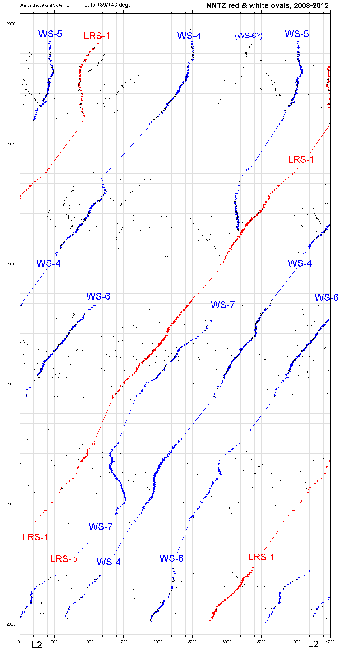
Click for the original size
Fig.A1. JUPOS chart of the red and white ovals in NNTZ, 2008-2012, in System II longitude. In this chart (unlike other JUPOS charts in this report), only bright spots and LRS-1 are shown: LRS-1 by red points, long-lived white ovals by blue points, and smaller or short-lived white spots by small black points.

Click for the original size
Fig. A2. The same as Fig.A1, presented in System III longitude.

Click for the original size
Fig. A3. Images in 2012 July-Sep. showing the tiny white oval (probably WS-7) which developed reddish colour in Sep., then being named LRS-b.
Table A1: NNTZ ovals, 2008-2012: Preliminary descriptive notes
| MB? | Visible appearance |
| LRS-1: |
| 2008 | ++ | Dull reddish light oval, dark rim. |
| 2009 | ++ | early (NNTB absent): Dark red. |
| later (NNTB restored): Red with dark rim. |
| 2010 | ++ | early: Central part strongly red. |
| later: Weakening until only slightly reddish. |
| 2011 | ++ | Weakly reddish, rim disappeared, v. low contrast. |
| 2012 | ++ | (NNTB absent): Dark red. |
| WS-4: |
| 2008 | - | White |
| 2009 | (+) | White |
| 2010 | (+) | White: large, with rim which later disappeared. |
| 2011 | + | White; quite large but shrinking; no rim |
| 2012 | (+) | White; small, v. low contrast. |
| WS-5: |
| 2008 | - | White |
| 2009 | (+) | Merged with LRS-1 in Sep. [see our report] |
| WS-6: |
| 2010 | (+) | White, v.bright, no rim |
| 2011 | (+) | White, no rim |
| 2012 | (+) | White, rim fading away |
| WS-7: |
| 2010 | - | Smallest |
| 2011 | (+) | Small but bright white, dark rim |
| 2012 | + | V.small: white, rimless, becoming light pink (LRS-2) |
|
Appendix 2:
NEBn: Dynamic interactions of spots
Figs.N1 to N5 present detailed alignments of images in five longitude sectors, to show these interactions of spots in the NEBn.
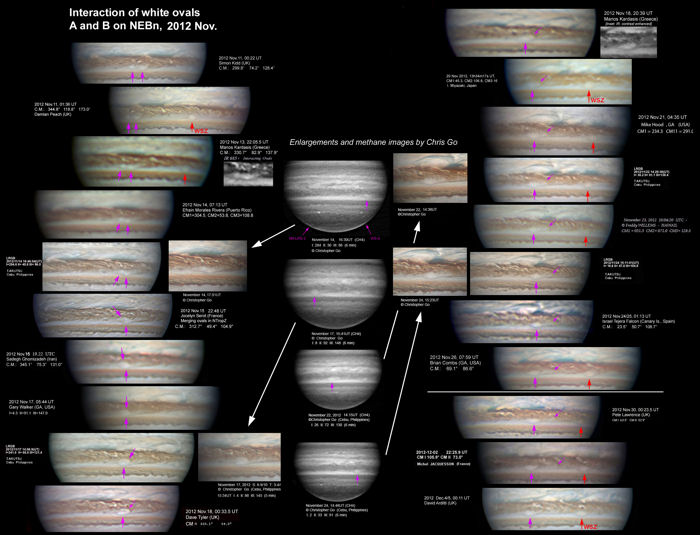
Click for the original size
Fig.N1 (L2 ~ 70): Merger of anticyclonic white ovals A and B. (A nice alignment has also been posted by Tomio Akutsu from his own images, up to the start of merger.) These two large AWOs converged in mid-Nov., and the process was very similar to previous such encounters observed in this latitude [see our web refs. below]. The f. one (WSA), slightly more northerly, originally with DL2 = -28 deg/mth, accelerated towards WSB and contacted it on Nov.14. They visibly circled round in close contact over 4 days, appearing to merge, but a small fragment of WSA emerged from the embrace on Nov.18-20 travelling f. (smaller purple arrow), and dissipated around Dec.2. Given the large size and high prograding speed (DL2 = -22) of the resulting AWO, it seems likely that the main parts of the two ovals did merge, but as in all previous well-observed examples in this latitude, a small fragment of one oval escaped but did not last long.
White spot Z, now a fully white oval with DL2 = -42 (!), although sometimes showing signs of disturbance, is now converging on the merged oval so a similar interaction could take place in the coming months.
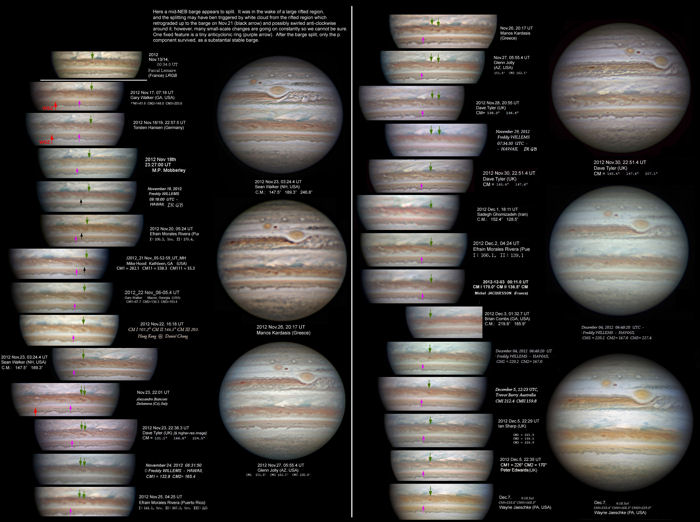
Click for the original size
Fig.N2 (L2 ~ 160): Here a mid-NEB barge appears to split. The barge (green arrow) was in the wake of a large rifted region, and the splitting may have been triggered by white cloud from the rifted region which retrograded up to the barge on Nov.21 (black arrow) and possibly swirled anticlockwise around it; however, many small-scale changes were going on constantly so we cannot be sure. After the barge split, only one component survived, as a substantial stable barge.

Click for the original size
Fig.N3 (L2 ~ 220): Here, two tiny barges (black arrows) converge and seem about to merge. However, as they are acome into contact on Dec.3, a bright streak erupts between them, rapidly sheared, and largely obscures the climax of the encounter. One small diffuse barge emerges but does not persist.
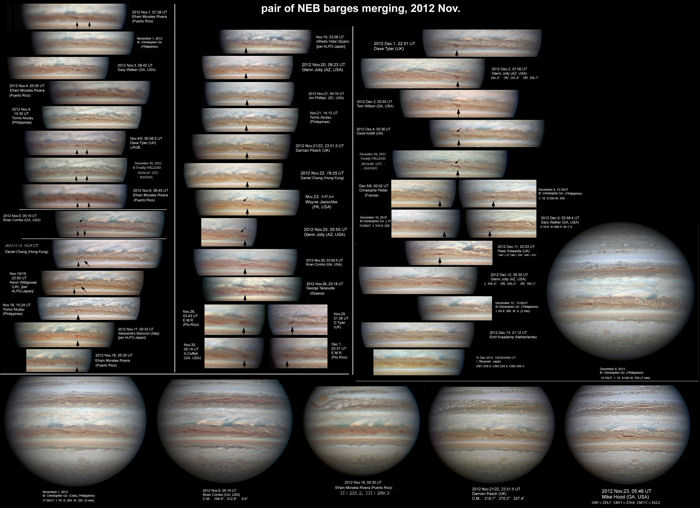
Click for the original size
Fig.N4 (L2 ~ 270): Here, two barges merge (black arrows); the process is very similar to previous barge mergers which we have observed [ref.6 & web refs. below]. Mergers of these cyclonic barges are more common and smooth and complete than mergers of AWOs; the barges merge as soon as they come into contact, but evidence of the two partners sometimes persists for some time as they continue on their courses within a common envelope before settling down. In this case the barges accelerated towards each other, and the f. barge elongated towards the p. one so much that it emitted a small fragment on Nov.6 (small black arrow), which streaked S of the p. barge on Nov.9. The main part of the f. barge encountered the p. one on Nov.14; a small bright cloud appeared between them but they rapidly merged, forming a conspicuous longer barge. Evidence of the two partners, circulating anticlockwise within a single envelope, persisted in the tilting and twisting of the merged barge. It was elongated Sp-Nf. from Nov.19-22, then a small streak detached from it to Sp. (small black arrow), and the remaining barge tilted Np-Sf. from Nov.26-29. At this time it rolled up, before unrolling around Dec.2-3 with a Sp-Nf. alignments and emission of another long streak to Sp., indicating that the merged barge had undergone a complete revolution since mid-November. It then tilted back to p-f. alignment around Dec.8, indicating that the circulation had still not fully stabilised.
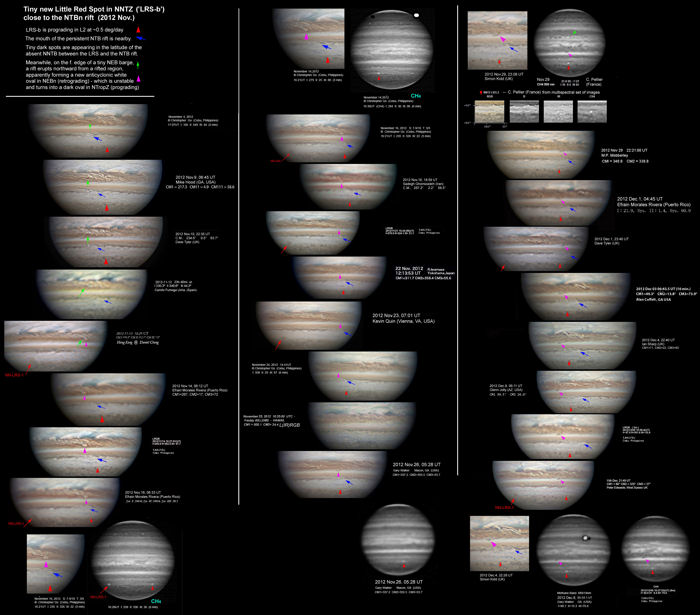
Click for the original size
Fig.N5 (L2 ~ 350): Interaction between a mid-NEB rift and a small barge generates a new spot in the NTropZ. On the f. edge of a tiny barge (green arrow), a rift erupts northward from a rifted region. (Surprisingly, it thrusts due N, contrary to the presumed circulation of the barge - similar to the way we have seen dark spots form in NTropZ in the early stages of NEB expansion events - see our 2009 reports.) The barge does not survive, and the rift transiently forms a new white oval in NEBn, which retrogrades from Nov.14-20. But this is unstable and turns into a small dark oval in NTropZ, rapidly prograding (DL2 ~ -46 deg/mth), which is also very dark in methane images.
Our previous reports of mergers in NEBn:
|
Appendix 3:
Equatorial Band: Tracking the f. end
Here I present a set of images of the f. end of the orange EB, which was the most well-defined part of it, from Aug.21 to Nov.10. The f. end was fixed at L1 = 355 in Aug., then started to move in increasing L1, with DL1 = +16 deg/mth from mid-Sep. to mid-Nov. This f. end appeared to be an irregular whitish cloud stably positioned south of a NEBs projection - a typical location for such clouds, although this one was unusually conspicuous (and esp. bright in early Nov.). It showed rapid short-term changes in shape, but no overall motion, even while the adjacent NEBs projection interacted strongly with passing rifts in the NEB (from Sep.11 until late Oct.). (Because of this variability, this NEBs projection/festoon does not show up very clearly on the JUPOS chart in Fig.8.)
A second f. end of the EB was visible in Oct. at L1 = 54 --> 58. This too was formed by a very bright and dynamic white cloud lying south of a NEBs dark projection and festoon, probably associated with it. This f. end and white cloud broke up in early Nov., but other such features could sometimes be seen at other longitudes.
Dark streaks on the EB south edge could occasionally be seen moving more slowly (more positive DL1) than the f. end of the EB, perhaps representing the usual slow wind speed at the equator (as in Fig.14), but there was no distinct motion of the orange material itself. Further scrutiny of the images, especially from animated map projections, might reveal more.
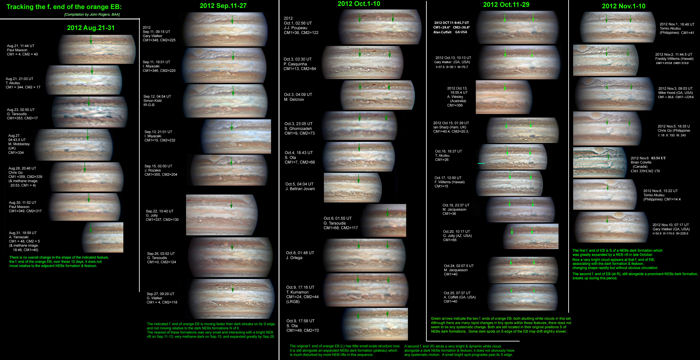
Click for the original size
Fig.EB1. Images of the f. end of the orange EB, from Aug.21 to Nov.10. (For hi-res versions and methane images, in Aug-Sep. see Fig.10, and in Nov. see Fig.EB2.)

Click for the original size
Fig.EB2. Images of the dual f. ends of the orange EB, Nov.1-10, with companion methane images of the whole disk.
|
Appendix 4:
SEBn: A new SED?
There is strong evidence that a new S. Equatorial Disturbance (SED) is forming. The main evidence is from the JUPOS chart (Fig.S1a). Since 2012 Aug. it has shown the familiar dynamical signature of a SED, that is, a band of low spot density, moving with positive DL1 (~ +24 deg/mth), which represents the SED itself, and a gradient of speed for the chevrons, whose speed increases eastward from the SED. Fig.S2 shows this gradient; in general it is similar to the gradients observed in previous years with a conspicuous SED, with speeds increasing from minimum -1.0 deg/day just p. the SED to -3.4 deg/day just f. it; although there is more scatter, due to the presence of speeds in the range DL1 = -2.4 to -3.3 deg/day at most longitudes.
The previous SED, which existed from 1999 to 2009 or possibly 2010, showed this dynamical signature whenever it was visually conspicuous, as we have reported in a series of papers [refs. S1-S4, below]. The history of that SED is summarised in our website report [ref.S5]. It disappeared in late 2009 or mid-2010, during the SEB Fade. In retrospect, the new feature may have originated in summer 2011, as the JUPOS chart (Fig.S1b) shows three low-density bands with DL1 ~+26 deg/mth throughout the 2011 apparition, one of which aligns exactly with the putative SED track in 2012. However, no speed gradient was evident in 2011, nor was there any visible SED.
We therefore examined maps and images (Figs.S3, S4) to look for a visible SED at the longitude implied by the chart in 2012. A SED-like feature has occasionally been visible (notably around Sep.29 and Nov.15) but has not been a constant feature, lasting for only a few days at a time. In the images from Nov-Dec., green arrowheads label features in the relevant region which could be the SED - because there either is a rift in the SEBn, or a bright spot in EZ(S) -- but each one is transient and is soon replaced by another one ~10-30 deg. f. it.
In methane images, likewise, there are distinct dark features just p. the putative SED, but not yet the characteristic methane-dark ‘step’ at the SED itself.
Thus, the appearance in images would not at present be clear evidence for a SED. However, the situation is consistent with the early stages of the previous SED and with a model of it as a wave. In the early months of the previous SED in 1999, likewise, it was usually inconspicuous and variable, and the visible rift several times shifted ~10 deg. f., and the typical methane-dark appearance only developed after several months [ref.S1]. Some of the features indicated with green arrowheads in Figs.S3 & S4 may be not the SED itself, but chevron-like disturbances at its p. end, arising in the stormy sector that often manifests p. the SED. The SED itself may be a wave that has not yet fully appeared at the surface, manifested mainly as a quiet chevron-free stretch, within which little rifts repeatedly open up. The wave may be dynamically strong, but not yet fully visible. I propose that there is an incipient SED, ‘struggling to be born’, and that it will develop into a classical SED over the coming months.
The new feature looked more like a classical SED as it approached the GRS in late Dec. (Fig.S4). It passed the GRS on Dec.27, so I suggested that it might open up as a conspicuous SED soon thereafter. Indeed, on Jan.5 Chris Go reported that this feature had developed a rift in the SEBn and so looked like a classical SED (also seen in Luis Campos’ image on Jan.3). We will have to wait and see whether this will last.
SED refs:
S1. Rogers J, Mettig H-J, Peach D & Foulkes M (2003), JBAA 113 (no.1), 10-31.
Jupiter in 1999/2000, Part I: Visible wavelengths.
S2. Rogers JH, Cidadao A, Akutsu T, Mettig H-J, Peach D, Orton GS, JBAA 115 (no.2), 70-78 (2005). Jupiter in 2000/2001: Part III: The South Equatorial Disturbance: A large-scale wave in a prograde jet.
S3. Rogers JH & Mettig H-J. (2008), ‘Influence of Jupiter's South Equatorial Disturbance on jet-stream speed’. JBAA 118 (no.6), 326-334.
S4. Simon-Miller AA, Rogers JH, Gierasch PJ, Choi D, Allison MD, Adamoli G, Mettig H-J (2012). ‘Longitudinal variation and waves in Jupiter’s south equatorial wind jet.’
Icarus 218, 817-830. [doi:10.1016/j.icarus.2012.01.022]
S5. Rogers J (2012) ‘The life of the South Equatorial Disturbance, 1999-2010’
--see link from: http://www.britastro.org/jupiter/icarus.htm
Figures:
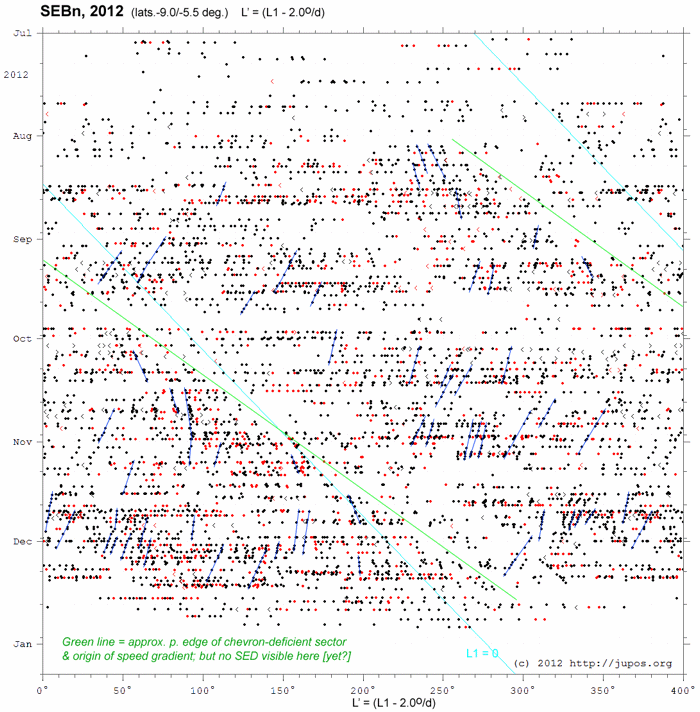
Click for the original size
Fig.S1. JUPOS charts of the SEBn in 2012:
(a) 2012 Jul-Dec.. The green line marks the approximate p. edge of the chevron-deficient sector with DL1 ~ +26 deg/mth. Blue lines mark the tracks of individual chevrons.
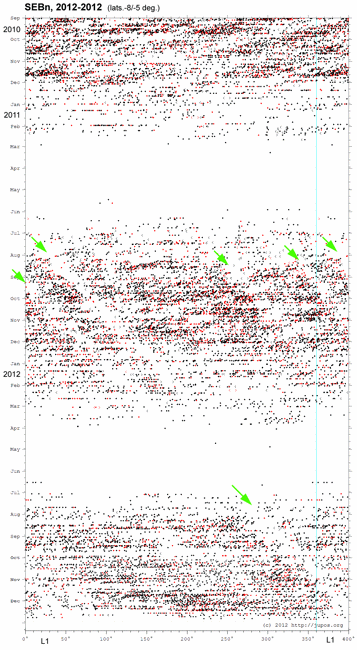
Click for the original size
Fig.S1. JUPOS charts of the SEBn in 2012:
(b) 2010-2012. Green arrows mark slow-moving chevron-deficient bands in 2011, one of which aligns with the similar band in 2012.
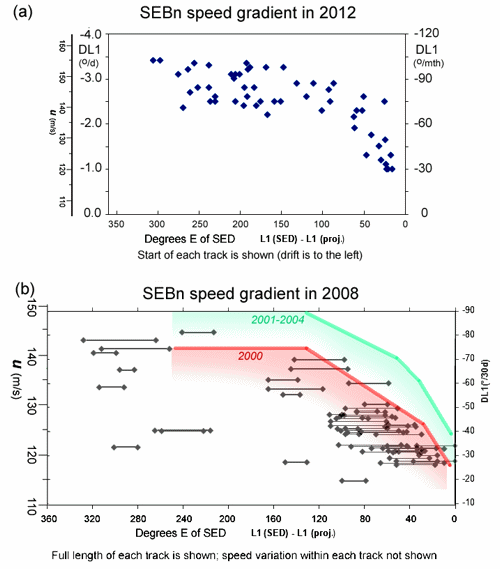
Click for the original size
Fig.S2. SEBn speed gradient in 2012 (a),
compared with results from previous years when the SED was present (b). In 2012, measurements are for the tracks marked in Fig.S1a, and because the SED is not consistently visible, distances are measured from the green line marking the chevron-deficient sector. In previous years this approximately coincided with the SED.
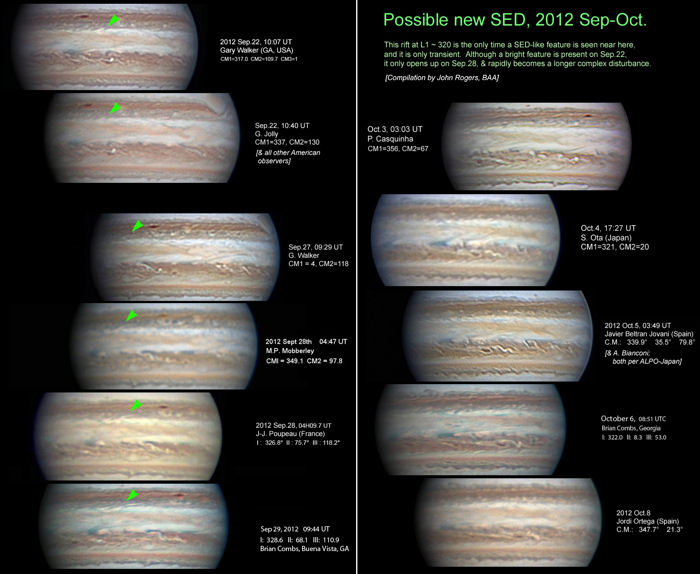
Click for the original size
Fig. S3. Images of the putative SED region, 2012 Sep.20-Oct.10. A rift opens up on Sep.28 (green arrowhead), producing a SED-like appearance in the expected position at the p. edge of the chevron-deficient sector, but it only lasts a few days.
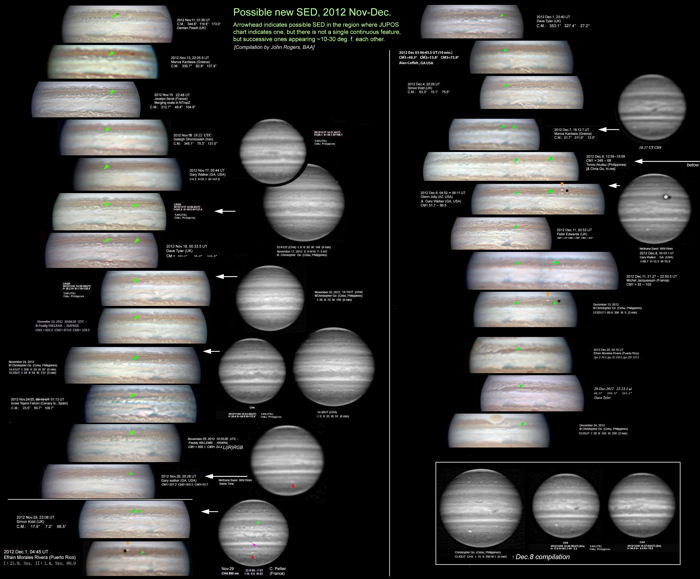
Click for the original size
Fig. S4. Images of the putative SED region, 2012 Nov.15-Dec.24. SED-like features are repeatedly seen in the expected position, but there is not a single continuous feature, rather, successive ones appearing ~10-30 deg. f. each other.
|
Appendix 5:
Zonal wind profiles
(results from Grischa Hahn)
Because of the high resolution of modern images, it is now possible to extract not just the drifts of distinct spots, but the east-west wind speeds across most latitudes (zonal wind profile), using the routine for correlating cylindrical projection maps made 10 or 20 hours apart, which Grischa Hahn recently created within WinJUPOS (http://jupos.org). Hahn has produced zonal wind profile from sets of images in Sep., Nov., and Dec., as shown in Fig.14. Note the very good agreement between the three profiles. The most substantial difference, in the SEB at latitudes 11-15 S, may be due to the fact that the ‘green’ profile includes the GRS and flanking regions, while the others do not; the same difference is also commonly seen within profiles from spacecraft.
In general, these are all very similar to previous profiles from spacecraft, confirming that the NEB and NTB Revivals have not altered the zonal wind profiles. They deviate from the New Horizons profile within the equatorial region, but agree much better with the Cassini profile (not shown), presumably due to real variations at cloud-top level from year to year.
All the jets are well defined, even those which carry no visible spots at present. Mean peak wind speeds and latitudes for the major jets from the 2012 profiles are as follows (mostly +/-4 m/s, +/-0.5 deg):
| u3 | Lat. |
| DL2 | DL1 |
|---|
| SEBs | -52 m/s | 19.5 S |
| +106 deg/mth |
|
| SEBn | +145 m/s | 7 S |
|
| -83 deg/mth |
| (Eq.) | +68 m/s | 0 N |
|
| +80 deg/mth |
| NEBs | +98 m/s | 7.5 N | (Sep,Nov.) |
| +16 deg/mth |
| ~+120 m/s | 7 N | (Dec.) |
| -29 deg/mth |
| NEBn | -19 m/s | 17 N |
| +33 deg/mth |
|
| NTBs | +145 m/s | 24 N |
|
| -106 deg/mth |
| NTBn | ~-20 m/s | 31 N |
| +40 deg/mth |
|
The value for SEBn agrees well with feature tracking (Appendix 4).
The value for NEBs in Sep-Nov. is the speed of the large dark ‘projections. However the faster value in Dec. corresponds to the speed of smaller features as recorded in some recent years, but not visible in the JUPOS charts this apparition, indicating that a faster wind speed is present in spite of the apparent dominance of the large dark projections.
The value for NTBs is interesting as it is intermediate between the ‘normal’ and ‘super-fast’ levels, as in 2005 and late 2007 [ref.9], before and after the super-fast outbreak in 2007. We should wait to see if it accelerates further in the next year or two, which would be predictive of another super-fast outbreak to come.

Click for the original size
Fig.14. Zonal wind profiles produced by G. Hahn from the indicated sets of images. The thin continuous line is the profile from New Horizons in 2007 for comparison. Because these speeds are very sensitive to slight inaccuracies in timing or registration of the images, the three profiles from 2012 have each been adjusted for optimum fit by adding or subtracting a speed increment across the whole profile.
|
Appendix 6:
Fireballs on Jupiter
A bright fireball was recorded on 2012 Sep.10 -- the third such event to be recorded by amateurs [ref.8]:
[2012 no.5] ‘Fireball on Jupiter, 2012 Sep.10.’
http://www.britastro.org/jupiter/2012_13report05.htm
Such events only last 1-2 seconds, and up to now, their detection has been limited by the requirement that someone is actually looking at the planet or at the video that they have taken of it. Now, Dr Ricardo Hueso has posted freely accessible software to scan webcam videos of Jupiter automatically for such flashes. His message is reproduced below, and serious imagers are encouraged to make use of this opportunity, so as to search for more impacts and establish their frequency.
From: Ricardo Hueso
Date: Tue, 23 Oct 2012 15:59:58 +0200
Subject: Jupiter impacts detection software available on PVOL-IOPW
Jupiter observation by amateur astronomers has steadily increased over the last years in number of observers and quality of the observations. The International Outer Planets Watch and its database of visual observations PVOL (http://www.pvol.ehu.es) store observations by many of you that have largely contributed to our advances in our knowledge of the dynamics of the jovian atmosphere. We have posted a software tool able to detect fireball impacts in Jupiter that could interest your attention. You can find this software on the PVOL webpage
http://www.pvol.ehu.es/software
or through the links in the PVOL webpage
http://www.pvol.ehu.es/
We warmfull acknowledge helpfull discussions and ideas shared with Emil Kraaikamp, Marc Delcroix and John H. Rogers. We hope the software will be helpfull to those of you interested in finding this type of Jupiter impacts.
Best regards,
Dr. Ricardo Hueso.
Ricardo Hueso Alonso
Fisica Aplicada I
Escuela Tecnica Superior de Ingenieria
Alda. Urquijo s/n, 48903, Bilbao
|
|
|
John Rogers (British Astronomical Association), 2013 Jan.
|
Jupiter in 2012/13: Interim report no.9
木星:中間レポート、2012年8月〜12月
Interim report on Jupiter, 2012 Aug.-Dec.
January 21, 2013
John Rogers (British Astronomical Association),
including results from the JUPOS team
(Gianluigi Adamoli, Michel Jacquesson, Marco Vedovato, Hans-Joerg Mettig & Grischa Hahn)
付録(Appendix)
付録1: NNTZ: 高気圧性白斑、2008-2012年 (Gianluigi Adamoli & John Rogers)
付録2: NEBn: 白斑の動的相互作用
付録3: Equatorial Band(赤道バンド): 後端の追跡
付録4: SEBn: 新しい南赤道攪乱(South Equatorial Disturbance)?
付録5: 帯状風プロファイル (Grischa Hahn)
付録6: 木星面上の火球 (Dr Ricardo Hueso)
|
付録 1:
NNTZ: 高気圧性白斑、2008-2012
Gianluigi Adamoli & John Rogers
これは、以前に【文献3】で記述したように、NNTZの高気圧性白斑の歴史を更新したものである。これらの歴史は図A1とA2(L2とL3と両方で示す)のJUPOSチャートにまとめられている。表A1(下記)には、高解像度画像やメタンバンド画像(089um)での外観の簡単な説明を示す。
いくつかの場合、ドリフトの変化のせいで、観測期の間の連結(破線で示す)は確かでないが、これらの連結から、これらがメタンブライト白斑だけであり、観測期内では出現や消失よりはかなり頻繁にドリフトを変化させているように見える。LRS-1の連続性は、それがいつも最大で最もメタンブライトであることから、疑いはない。
以前に説明したように【文献3】、白斑のいくつかは他よりはメタンブライト(MB)であるが、超高解像度画像では全てが少なくとも弱くメタンブライトである。メタン画像は近年改良されているので、このことは、以前はメタンブライトではなかったかもしれないが、白斑は今は弱くメタンブライトとして頻繁に分類されることを意味している。この中間レポートのために、一貫した調査を試みていない。しかし、いくつかの白斑は同じサイズの他の白斑よりメタンブライトであることは今も正しい。特に、2012年後半に、WS-6は大きいけれども、LRS-b(おそらく以前のWS-7)はWS-6よりメタンブライトである(たとえば、付録2の図N1)。
それぞれの白斑の歴史をまとめると(表A1)、
LRS-1は初めから終わりまで最大の白斑で、強くメタンブライトである。その目に見えるカラーは、強い赤(特にNNTBが存在しなかった2009年と2012年)と弱い赤味がかった色(周りと同じ色で、だからほとんど見えない、2011年)の間を変動し続けている。
WS-4は、縮小していた2012年まで、明らかにますますメタンブライトな白斑である。
WS-5は2009年9月にLRS-1とマージした【文献4】。
WS-6は2008年から小さくてメタンブライトではない白斑として存在していたが、小さいが非常に明るい白色であった2010年に初めて名前を付けられた。それ以降弱いメタンブライトとして持続している(図12を参照)。
WS-7も2010年に出現し、いつも小さかったが、もし観測期の間の連続性が正しいならば、2012年9月にますますメタンブライトになり、明るい白色から明るいピンクへ変化したので、仮符号LRS-bを与える(図A3と図4)。
参考文献
3. Rogers JH, Adamoli G & Mettig H-J (2011) ‘Jupiter’s high-latitude storms: A Little Red Spot tracked through a jovian year.’ JBAA 121 (no.1), 19-29.
4. [2009 no.7] Jupiter in 2009: Interim Report, with new insights into the NTZ disturbance, NEB expansion, and SEB fading. http://www.britastro.org/jupiter/2009report07.htm
図

Click for the original size
図A1 2008-2012年のNNTZの赤色白斑と白色白斑JUPOSチャート、体系II。このチャートでは(このレポートの他のJUPOSチャートと違って)、白斑とLRSだけを示す。赤点でLRSを、青点で長寿命白斑を、小黒点で短寿命白斑を示す。

Click for the original size
図A2 図A1と同じ、体系IIIで示す。

Click for the original size
図A3 2012年7月-9月の画像、9月に赤味がかった色に発達した小さな白斑(おそらくWS-7)を示す、その後LRS-bと名前を付ける。
Table A1: NNTZ ovals, 2008-2012: Preliminary descriptive notes
| MB? | Visible appearance |
| LRS-1: |
| 2008 | ++ | Dull reddish light oval, dark rim. |
| 2009 | ++ | early (NNTB absent): Dark red. |
| later (NNTB restored): Red with dark rim. |
| 2010 | ++ | early: Central part strongly red. |
| later: Weakening until only slightly reddish. |
| 2011 | ++ | Weakly reddish, rim disappeared, v. low contrast. |
| 2012 | ++ | (NNTB absent): Dark red. |
| WS-4: |
| 2008 | - | White |
| 2009 | (+) | White |
| 2010 | (+) | White: large, with rim which later disappeared. |
| 2011 | + | White; quite large but shrinking; no rim |
| 2012 | (+) | White; small, v. low contrast. |
| WS-5: |
| 2008 | - | White |
| 2009 | (+) | Merged with LRS-1 in Sep. [see our report] |
| WS-6: |
| 2010 | (+) | White, v.bright, no rim |
| 2011 | (+) | White, no rim |
| 2012 | (+) | White, rim fading away |
| WS-7: |
| 2010 | - | Smallest |
| 2011 | (+) | Small but bright white, dark rim |
| 2012 | + | V.small: white, rimless, becoming light pink (LRS-2) |
|
付録2:
NEBn: 白斑の動的相互作用
図N1-N5は、NEBnのこれらの白斑の相互作用を示すために、5個の経度セクターに画像を詳細に整列したものである。

Click for the original size
図N1 (L2=約70度): 高気圧性白斑AとBのマージ。(素晴らしい整列は、マージの開始までを、Tomio Akutsuによって彼自身の画像から報告された)。これらの2個の大きなAWOは11月中旬に収れんしたが、その過程はこの緯度でこれまでに観測されたこのような衝突と非常に似ていた【我々の下記webの文献を参照】。わずかに北寄りの後方の白斑(WSA)は、最初はDL2=-28度/月だったが、WSBに向かって加速し、11月14日に接触した。これらは明らかに4日以上接触して回転し、マージしたように見えたが、11月18-20日にWSAの小さなフラグメントが後方に抱擁物から放出され(小さな紫色の矢印)、12月2日頃に散逸した。残ったAWOの巨大なサイズや大きな前進速度(DL2=-22度/月)を考えると、2個の白斑の主な部分はマージしたように見えるが、この緯度でこれまでに良く観測された例のように、一つの白斑のフラグメントがのがれたが、長くは続かなかった。
現在はDL2=-42度/月(!)を持つ完全な白斑であるWSZは、時々攪乱の兆候を見せているけれども、今はマージした白斑に収れんしていて、今後数ヵ月で同様な相互作用が起こるだろう。

Click for the original size
図N2 (L2=約160度):ここではNEB中央のバージが分裂しているように見える。バージ(緑色矢印)は巨大なリフト領域のすぐあとにあって、11月21日にバージまで後退し(黒色矢印)、おそらくその周りに反時計方向に渦巻くリフト領域からの白雲によって、分裂は引き起こされているかもしれない。しかしながら、多くの小規模な変化が絶えず起こっていたが、確認はできない。バージの分裂後に、実質的な安定したバージとして、一つの成分だけが生き残った。

Click for the original size
図N3 (L2=約220度): ここでは、2個の小さなバージ(黒色矢印)が収れんして、マージしているように見える。しかしながら、12月3日にそれらは接触している時に、明るいストリークがそれらの間に噴出し、急速にシアーされ、衝突のクライマックスを広くあいまいにしている。一つの拡散した小バージが出現しているが、持続はしていない。

Click for the original size
図N4 (L2=約270度): ここでは、2個のバージがマージしている(黒色矢印)。過程は我々が観測した以前のバージのマージと非常に似ている【文献6、下記web文献】。これらの低気圧性バージのマージはAWOのマージよりは一般的で、スムースで、完全である。バージは接触するとすぐにマージするが、2個のパートナーの証拠は時々、沈静化する前に共通の囲い内のコース上にあり続けるように、ある時間持続している。この場合、バージはお互いに向かって加速し、後方のバージはあまりに長く前方のバージに向かって伸びたので、11月6日に小さなフラグメントを放出して(黒色の小さな矢印)、11月9日に前方のバージの南に流れ出た。後方のバージの大部分は11月14日に前方のバージと出会った。それらの間に小さな明るい雲が出現したが、それらは急速にマージして、目立った長いバージを形成した。単一の囲いの内部を反時計回りに循環するという、2個のパートナーの証拠はマージしたバージの傾きやねじれを持続した。これは11月19-22日から南前方ー北後方に伸び、その後小さなストリークがそこから南前方まで離れ(黒色の小さな矢印)、残ったバージが11月26-29日から北前方ー南後方に傾いた。この時、12月2-3日頃に南前方ー北後方の整列や南前方への他の長いストリークに広がる前に、丸くなり、このことはマージしたバージが11月中旬以降に完全な変動を受けていたことを示す。その後12月8日頃に前方ー後方の整列に傾き、このことは循環気流が今は完全に安定していないことを示す。

Click for the original size
図N5 (L2=約350度): NEB中央のリフトと小さなバージとの間の相互作用はNTropZに新しい斑点を生成する。小さなバージ(緑色矢印)の後端に、リフト領域から北にリフトが出現する。(NEB拡幅現象の初期段階で暗斑がNTropZに形成されるのを見たのと同様に【我々の2009年のレポート参照】、驚くことに、リフトはバージの推定される循環気流に反して真北に押し出す)。バージは生き残らなくて、リフトが一時的にNEBnに白斑を形成し、11月14-20日から後退する。しかし、これは不安定で、NTropZの小さな暗斑に変化し、急速に前進(DL2=約-60度/月)し、これもメタン画像で非常に暗い。
Our previous reports of mergers in NEBn:
|
付録3:
赤道バンド: 後端の追跡
ここでは、8月21日〜11月10日の、それを最も良く表しているオレンジ色のEBの後端の画像セットを示す。後端は8月にはL1=355度で固定していたが、その後8月から11月中旬までDL1=+16度/月でL1の経度増加方向に移動し始めた。後端はNEBsプロジェクションの南に安定して位置する不規則な白っぽい雲のように見えた。これはこのような雲の典型的な位置であるが、異常に目立っていた(さらに11月上旬に特に明るかった)。隣接するNEBsプロジェクションはNEBのリフトの通過によって強く相互作用した(9月11日から10月下旬まで)けれども、これは全体の動きではなく、形の急速で短期的な変化を示した。(このばらつきのために、このNEBsプロジェクション/フェストーンは図8のJUPOSチャートにあまりはっきりとしない)。
第2のEB後端が10月にL1=54⇒58度に見られた。これも、おそらく関係するNEBsの暗いプロジェクションやフェストーンの南に位置する非常に明るくてダイナミックな白雲によって形成された。この後端と白雲は11月上旬に消失したが、他のこのような模様が時々他の経度に見られただろう。
EB南縁のダーク・ストリークは、時々、おそらく赤道で通常の低速な風速を示す(図14のように)、EBの後端よりはもっと低速(もっとプラスのDL1)で移動しているように見えたが、オレンジ色の物質自体のはっきりと動きはなかった。画像、特にマップ動画のさらなる調査がよりはっきりとさせるかもしれない。

Click for the original size
図EB1 8月21日から11月10日までのオレンジ色のEB後端の画像。(高解像度版とメタン画像について、8-9月は図10を、11月は図EB2を参照)。

Click for the original size
図EB2 11月1-10日のオレンジ色のEBの二重の画像、木星像全体のメタン画像と一緒に。
|
付録4:
SEBn: 新しいSEDか?
新しい南赤道攪乱【S. Equatorial Disturbance (SED)】が形成されている強い証拠がある。主な証拠はJUPOSチャート(図S1a)から得られる。2012年8月以来、SEDの同様なダイナミックなサイン、すなわち、SED自体を示す、プラスのDL1(約+24度/月)で移動する低い斑点濃度のバンドと、速度がSEDから東方に増加する山形状の速度勾配を示している。図S2にこの勾配を示す。一般的に、これは目立ったSEDについて過去に観測された勾配に似ていて、速度はSED直前の最小である-1.0度/日からSED直後の-3.4度/日まで増加している(ほとんどの経度でDL1=-2.4〜-3.3度/日の範囲の速度が存在するために、分散は大きいけれども)。
以前のSED(1999年から2009年かおそらく2010年まで存在した)は、我々が論文【下記文献S1-S4】で報告したように、眼視で顕著である時には、このダイナミックなサインを示した。SEDの歴史を我々のwebサイトレポート【文献S5】にまとめている。これはSEBが淡化している間の、2009年後半か2010年半ばに消失した。振り返ると、JUPOSチャート(図S1b)が2011年の観測期間中DL1=約+26度/月を持つ3個の低濃度のバンドを示し、そのうちの一つが2012年の推定されるSEDトラックと正確に一直線にそろうので、2011年夏に新しい模様が生じたかもしれない。しかしながら、2011年に速度勾配の証拠はなかったし、いかなる目に見えるSEDもなかった。
それで我々は、2012年のチャートによって暗示される経度に目に見えるSEDを探すために、マップや画像(図S3,S4)を調べた。SEDのような模様は時々見えた(特に9月29日と11月15日頃)が、不変な模様ではなく、ある時に数日だけ継続するものであった。 11-12月の画像に、SEDであるかもしれない該当する領域の模様に緑色の矢印を付けている。SEBnのリフトか、EZ(S)の白斑かどちらかがあるが、一方は一時的であり、その10-30度後方のもう一つによってすぐに置き換えられる。
メタン画像では、同様に、推定されるSEDの直前に目立った暗い模様があるが、SED自体はまだ特徴的であるメタンダークな段階ではない。
したがって、画像の外観からは現時点ではっきりとしたSEDの証拠はない。しかしながら、状況は以前のSEDの初期段階や波のようなそのモデルと一致している。1999年のSEDの初期の数ヵ月は、同様に、通常は目立たなくて変化し、目に見えるリフトが何回も10度後方にシフトし、典型的なメタンダークの外観だけが数ヵ月後に発達した【文献S1】。図S3,S4で緑色矢印で示されるいくつかの模様は、SED自体ではなくて、SEDの前方でしばしば明瞭になる嵐のセクターに起こる、その前端の山形状の攪乱である。SED自体はまだ完全に表面に現れていない波かもしれなくて、静かな山形状のないストレッチとして主に現れ、その内部に小さなリフトが繰り返し現れた。波は動的に強いが、まだ完全に見えていない。私は、『生まれるのに苦労する』初期のSEDがあり、今後数ヵ月のうちに古典的なSEDに発達するだろう、と考えている。
新しい模様は、12月下旬に大赤斑に接近すると、さらに古典的なSEDのように見えた(図S4)。これは12月27日に大赤斑を通過し、それでその後すぐに目立ったSEDとして活動を始めた。確かに、1月5日にChris Goはこの模様がSEBnにリフトを発達させて、それで古典的なSEDのように見えると報告した(1月3日のLuis Camposの画像にも見られる)。我々は待って、これが継続するかどうかを確認する必要がある。
SEDの文献:
S1. Rogers J, Mettig H-J, Peach D & Foulkes M (2003), JBAA 113 (no.1), 10-31.
Jupiter in 1999/2000, Part I: Visible wavelengths.
S2. Rogers JH, Cidadao A, Akutsu T, Mettig H-J, Peach D, Orton GS, JBAA 115 (no.2), 70-78 (2005). Jupiter in 2000/2001: Part III: The South Equatorial Disturbance: A large-scale wave in a prograde jet.
S3. Rogers JH & Mettig H-J. (2008), ‘Influence of Jupiter's South Equatorial Disturbance on jet-stream speed’. JBAA 118 (no.6), 326-334.
S4. Simon-Miller AA, Rogers JH, Gierasch PJ, Choi D, Allison MD, Adamoli G, Mettig H-J (2012). ‘Longitudinal variation and waves in Jupiter’s south equatorial wind jet.’
Icarus 218, 817-830. [doi:10.1016/j.icarus.2012.01.022]
S5. Rogers J (2012) ‘The life of the South Equatorial Disturbance, 1999-2010’
--see link from: http://www.britastro.org/jupiter/icarus.htm
図:

Click for the original size
図S1 2012年のSEBnのJUPOSチャート:
(a) 2012年7-12月。緑色線はDL1=約+26度/月の山形状模様のないセクターのおよそ前端を示す。青色線は個別の山形状模様のトラックを示す。

Click for the original size
図S1 2012年のSEBnのJUPOSチャート:
(b) 2011-2012年。緑色矢印は2011年に低速移動する山形状模様のないバンドを示し、その一つは2012年の同様なバンドと一直線に並ぶ。

Click for the original size
図S2 2012年のSEBn速度勾配(a)、
SEDが存在していた時の過去の結果(b)と比較する。2012年の測定は図S1aでマークされたトラックについて行われ、SEDは一貫しては見えないので、距離は山形状模様のないセクターを示す緑色線から測定されている。過去には、これはほぼSEDと一致した。

Click for the original size
図S3 2012年9月20日〜10月10日の推定されるSED領域の画像。9月28日にリフトが活動を始め(緑色矢印)、山形状模様のないセクターの前端の予想位置にSEDのような外観を見せたが、数日しか続かなかった。

Click for the original size
図S4 2012年11月15日〜12月24日の推定されるSED領域の画像。SEDのような模様が予想位置に繰り返し見られるが、単一の連続した模様はなくて、むしろお互いに10-30度後方に出現する連続模様がある。
|
付録5:
帯状風プロファイル
(Grischa Hahnからの結果)
現代の高解像度のおかげで、現在は、明確な白斑のドリフトではなく、Grisha Hahnが最近WinJUPOS (http://jupos.org)に作成した、10時間か20時間離れて作成された円筒投影マップを相関するためのルーチンを使用して、多くの緯度の東西風速を取り出すことができる。図14に示すように、Hahnは9,11,12月の画像から帯状風プロファイルを作成した。3個のプロファイルは非常に良い一致を示すことに注意。南緯11-15度のSEBの最も大きな差は、緑色のプロファイルが大赤斑と隣接領域を含み、他はそうでないという事実によるものかもしれない。同じ差は探査機からのプロファイル内にも共通に見られる。
一般的に、これらは過去の探査機からのプロファイルと非常に似ていて、NEB復活とNTB復活は帯状風プロファイルを変更していないことを確認できる。これらは赤道領域でNew Horizonsプロファイルから外れているが、Cassiniプロファイル(非表示)とはかなり良く一致していて、これはおそらく年々雲頂レベルで本当に変化していることによる。
現時点で目に見えない斑点さえ、全てのジェット気流が良く分かる。2012年プロファイルから、主なジェット気流の平均ピーク風速と緯度は以下の通りである(ほとんどは±4m/s、±0.5度)。
| u3 | Lat. |
| DL2 | DL1 |
|---|
| SEBs | -52 m/s | 19.5 S |
| +106 deg/mth |
|
| SEBn | +145 m/s | 7 S |
|
| -83 deg/mth |
| (Eq.) | +68 m/s | 0 N |
|
| +80 deg/mth |
| NEBs | +98 m/s | 7.5 N | (Sep,Nov.) |
| +16 deg/mth |
| ~+120 m/s | 7 N | (Dec.) |
| -29 deg/mth |
| NEBn | -19 m/s | 17 N |
| +33 deg/mth |
|
| NTBs | +145 m/s | 24 N |
|
| -106 deg/mth |
| NTBn | ~-20 m/s | 31 N |
| +40 deg/mth |
|
SEBnの値は模様追跡と良く一致している(付録4)。
9-11月のNEBsの値は大きな暗いプロジェクションの速度である。しかしながら、12月の高速の値は最近数年間に記録された小さな模様の速度に該当するが、この観測期にはJUPOSチャートに見えない。このことは、大きな暗いプロジェクションの見かけの優位性の替わりに、より速い風速が存在することを意味する。
NTBsの値は、2007年の超高速outbreakの前後である、2005年と2007年後半のように、通常と超高速の間の中間であるので、興味深い【文献9】。別の超高速outbreakが発生する前兆である、1、2年後にさらに加速するかを確認するために待つ必要がある。

Click for the original size
図14 指定された画像セットからG. Hahnによって作成された帯状風プロファイル。細い実線は比較のための2007年のNew Horizonsのプロファイルである。これらの速度は画像のタイミングや登録のわずかな不正確さに非常に敏感であるので、2012年からの3個のプロファイルはそれぞれ、プロファイル全体に速度増分を加算や減算することによって最適フィットを調整している。
|
付録6:
木星面上の火球
2012年9月10日、明るい火球が記録された。これはアマチュアによって記録された3番目の現象である【文献8】。
[2012 no.5] ‘Fireball on Jupiter, 2012 Sep.10.’
http://www.britastro.org/jupiter/2012_13report05.htm
このような現象は1-2秒しか継続しなくて、今までは、誰かが実際に木星か撮影されたビデオを見ているという要求から、検出は制限されている。現在、Ricardo Hueso博士は、このような発光のために自動的に木星のwebcamビデオをスキャンするフリー・ソフトウェアを公開している。彼のメッセージを下記に再掲載するが、重要な撮影者はこの機会を利用するように奨励されているので、より多くの衝突を探したり、その頻度を確立したりできる。
From: Ricardo Hueso
Date: Tue, 23 Oct 2012 15:59:58 +0200
Subject: PVOL-IOPWで利用可能な木星衝突検出ソフトウェア
アマチュアによる木星観測は観測者数や観測の品質において昨年から着実に増えている。IOPW(The International Outer Planets Watch)とその眼視観測データベースPVOL (http://www.pvol.ehu.es)では、木星大気のダイナミクスの我々の知識における進歩に大きく貢献している、多くの皆さんによる観測を蓄積している。皆さんが興味を持つ木星の火球衝突を検出可能なソフトウェア・ツールを公開している。このソフトウェアはPVOLのwebページから入手できる。
http://www.pvol.ehu.es/software
あるいは、PVOL webページのリンクから。
http://www.pvol.ehu.es/
我々は、Emil Kraaikamp, Marc Delcroix, John H. Rogersと有用な議論とアイデアを共有できることに感謝する。我々は、ソフトウェアがこのタイプの木星衝突を見つけることに興味を持つ皆さんに役立つことを願っている。
Dr. Ricardo Hueso.
Ricardo Hueso Alonso
Fisica Aplicada I
Escuela Tecnica Superior de Ingenieria
Alda. Urquijo s/n, 48903, Bilbao
|
|
|
John Rogers (British Astronomical Association), 2013 Jan.
【日本語訳:伊賀祐一 (Yuichi Iga)】
|































